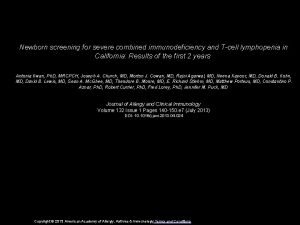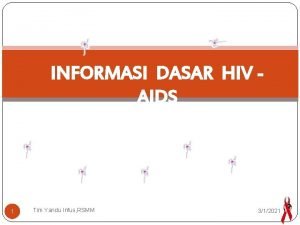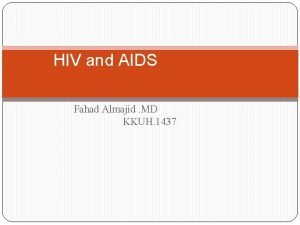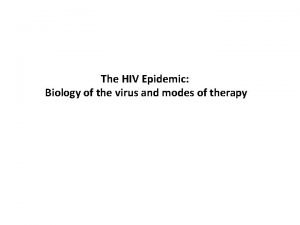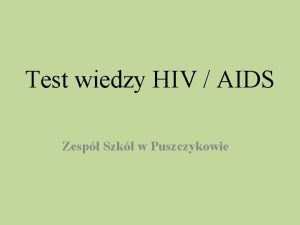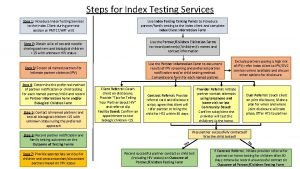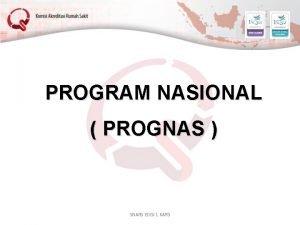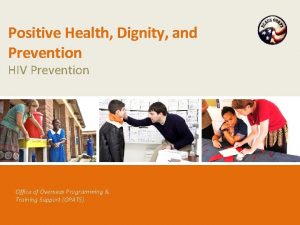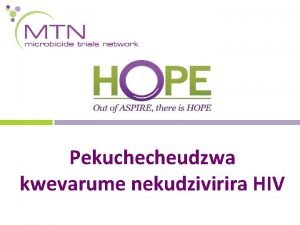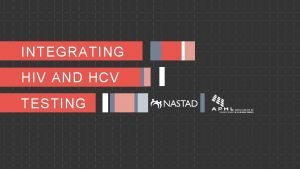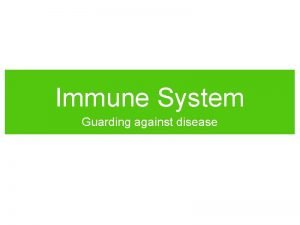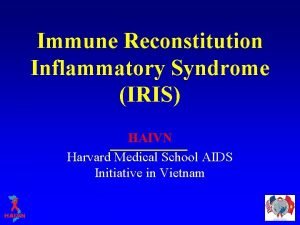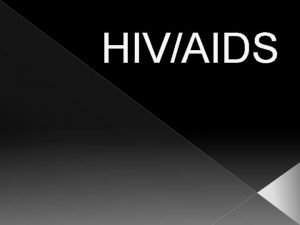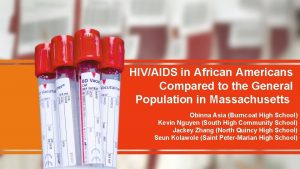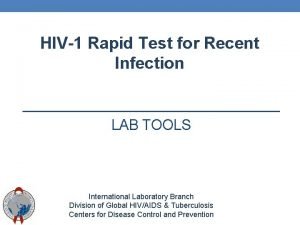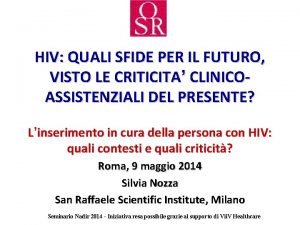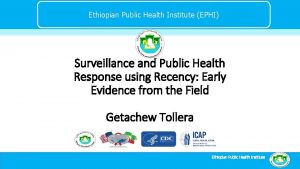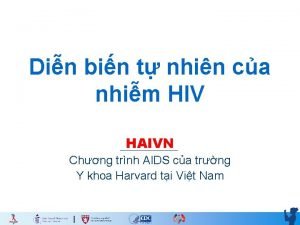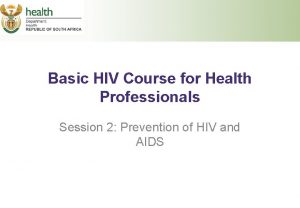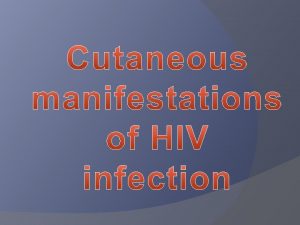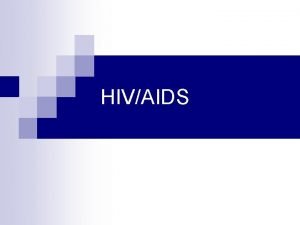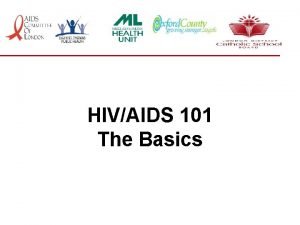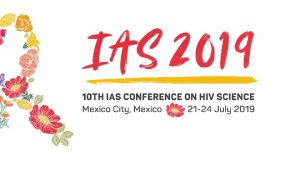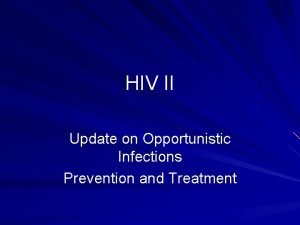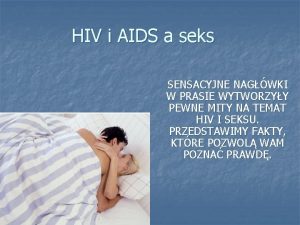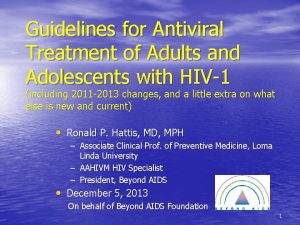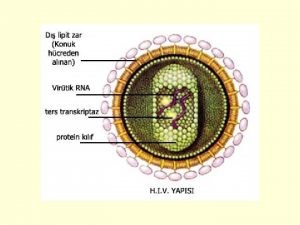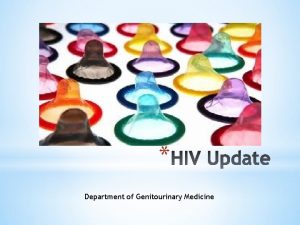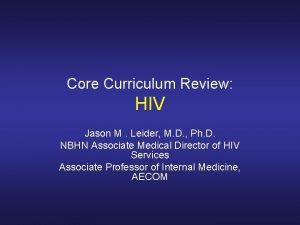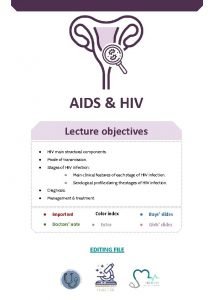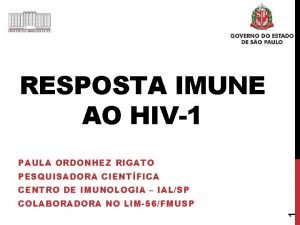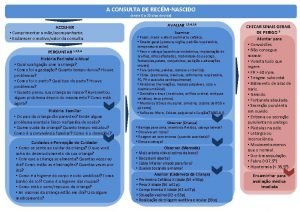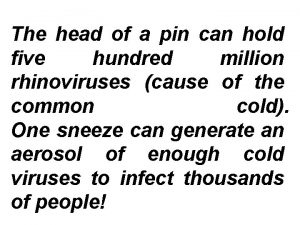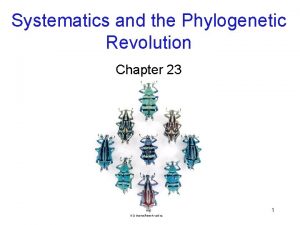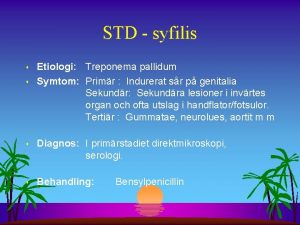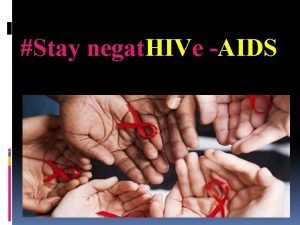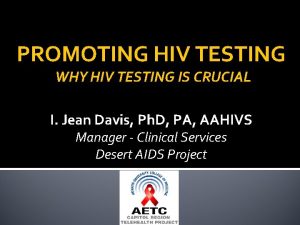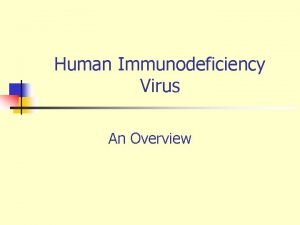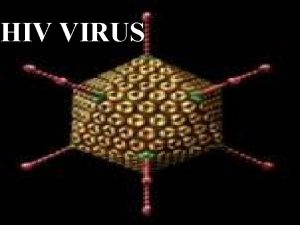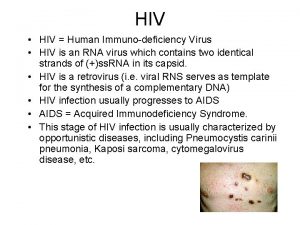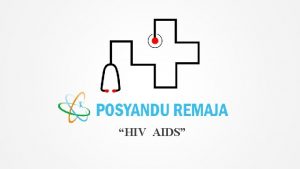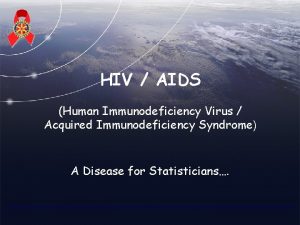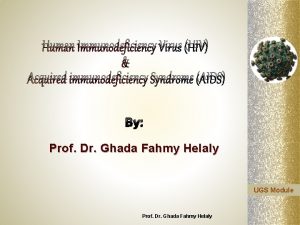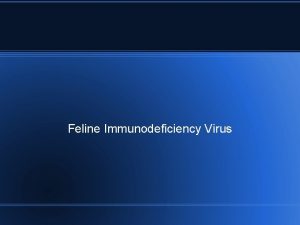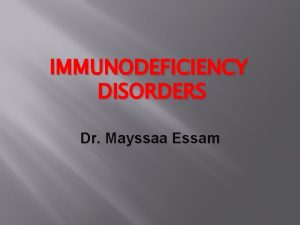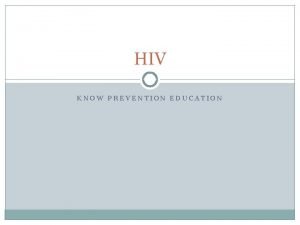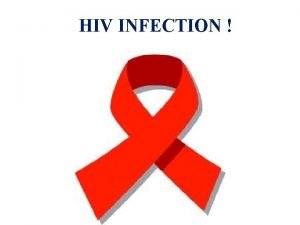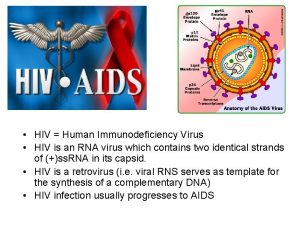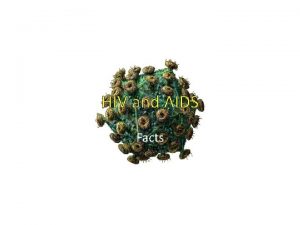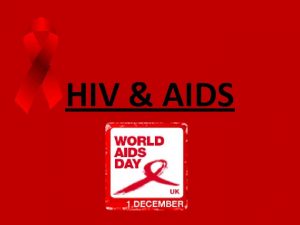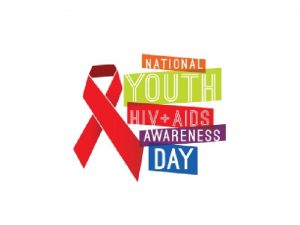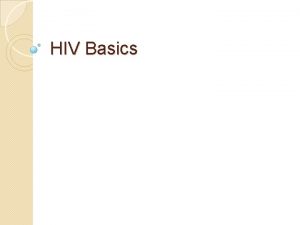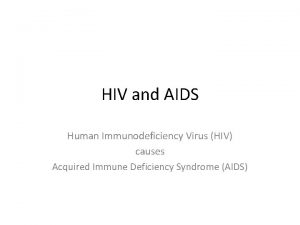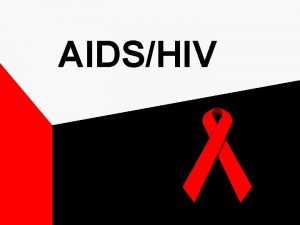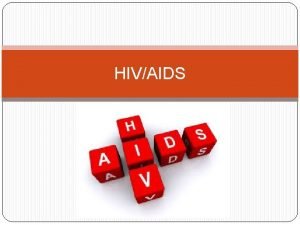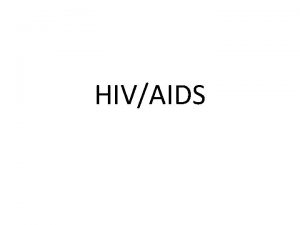HIV Human Immunodeficiency Virus virus yang menyerang system
















































- Slides: 48

HIV (Human Immunodeficiency Virus), virus yang menyerang system kekebalan tubuh manusia kemudian menimbulkan AIDS

HIV kelompok retrovirus dapat “mengkopi-cetak” materi genetik diri di dalam materi genetik sel-sel yg ditumpangi, Dengan proses ini HIV dapat mematikan sel-sel T-4. AIDS (Acquired Immune Deficiency Syndrome) merupakan kumpulan gejala penyakit akibat menurunnya sistem kekebalan tubuh oleh HIV.

virus penyebab AIDS, HIV-1 dan HIV-2. HIV-1 paling banyak di daerah Eropa Barat, Asia dan Afrika Tengah, Selatan dan Timur. HIV-2 terutama ditemukan di Afrika Barat. The vast majority of HIV-1 infections occurs as a result of unprotected sexual intercourses.

AIDS has killed more than 28 million people 3. 6 million people dying in 2005 alone [Source: Avert]. many cases go unreported, the prevalence of the disease is increasing. By comparison: The flu pandemic of 1918 killed approximately 20 million people worldwide. World War II killed approximately 40 million people.

The regions with the greatest number of people living HIV/AIDS, (World Health Organization), include: Sub-Saharan Africa - 25. 8 million South and Southeast Asia - 7. 4 million Latin America - 1. 8 million North America - 1. 2 million Eastern Europe/Central Asia - 1. 6 million (Avert)



PENULARAN HIV Sexual contact Sharing contaminated intravenous needles Breastfeeding (mother to baby) Infected mother to fetus during pregnancy or birth Blood transfusions (Rare in countries where blood is screened for HIV antibodies. ) HIV does not reproduce in insects, virus doesn't survive in the mosquito long enough to be transmitted in the saliva.

The regions with the greatest number of people living HIV/AIDS, (World Health Organization), include: Sub-Saharan Africa - 25. 8 million South and Southeast Asia - 7. 4 million Latin America - 1. 8 million North America - 1. 2 million Eastern Europe/Central Asia - 1. 6 million (Avert)

HIV/AIDS History 1926 -46 - HIV possibly spreads from monkeys to humans. No one knows for sure. 1959 - A man dies in Congo in what many researchers say is the first proven AIDS death. 1981 - The Centers for Disease Control and Prevention (CDC) notices high rate of otherwise rare cancer 1982 - The term AIDS is used for the first time, and CDC defines it. 1983/84 - American and French scientists each claim discovery of the virus that will later be called HIV. 1985 - The FDA approves the first HIV antibody test for blood supplies. 1987 - AZT is the first anti-HIV drug approved by the FDA. 1991 - Basketball star Magic Johnson announces that he is HIV-positive. 1996 - FDA approves first protease inhibitors. 1999 - An estimated 650, 000 to 900, 000 Americans living with HIV/AIDS. 2002 - AIDS global death toll reaches nearly 28. 1 million.

Cara kerja virus HIV Virus menempel pada reseptor protein CD 4, di selaput bagian luar Lympocyt. CD 4 adalah marker ( penanda) di permukaan sel-sel darah putih manusia, (terutama sel-sel limfosit). Sel-sel memiliki reseptor CD 4 disebut sel CD 4+ (limfosit T penolong=T helper).

LIFE CYCLE HIV

LIFE CYCLE HIV

LIFE CYCLE HIV

LIFE CYCLE HIV 1. HIV attaches to and penetrates its target cell 2. HIV releases RNA, the genetic code of the virus, into the cell. RNA converted to DNA. (by an enzyme reverse transcriptase). HIV mutates easily at this point because reverse transcriptase 3. The viral DNA enters the cell's nucleus. 4. WITH an enzyme called integrase, the viral DNA becomes integrated with the cell's DNA(HUMAN) 5. The DNA of the infected cell now produces RNA to assemble a new HIV. 6. A new virus is assembled from RNA and short pieces of protein. 7. The virus pushes (buds) through the membrane of the cell, wrapping itself in a fragment of the cell membrane and pinching off from the infected cell. 8. To infect the budded virus must mature. It becomes mature when another HIV enzyme (HIV protease) cuts structural proteins in the virus, causing them to rearrange.

CICLUS hidup HIV VIRUS

the CD 4+ cells ("T-helper) damage Damage to a person's immune system is measured by counting the CD 4+ cells ("T-helper" ) These cells are very important for the integrity of the immune system. (limf. B, makrofag dan limf. T sitotoksik) The CD 4+ cell in a healthy person is 500 and 1, 500 cells in each microliter (µl) blood

Bulan pertama terinfeksi HIV, CD 4+ turun 40 -50% (bisa menularkan HIV) , banyak partikel virus di dalam darah. 6 bulan, jumlah partikel virus di darah kadarnya stabil, (berlainan pada setiap penderita). Perusakan sel CD 4+ dan penularan berlanjut. Kadar partikel virus yang tinggi dan kadar limfosit CD 4+ yang rendah Dapat menentukan orang-orang yang beresiko tinggi menderita AIDS.

FASE PERJALANAN PENYAKIT 1. Fase “periode jendela” (window period). Titer antibody HIV belum bisa diukur (3 -6 bulan) 2. Fase latent Penyakit berhenti berkembang selama 1 -20 bulan (titer antibodi HIVtetap positif) 3. Aids syndrome lengkap Beberapa tahun timbul gambaran klinik AIDS (26 bln – 10 th setelah HIV +)

aid acute latent

ANATOMI VIRUS BASIC PART OF HIV VIRUS. 1. VIRAL ENVELOPE 2. P 17 PROTEIN 3. VIRAL CORE

ANATOMI VIRUS All Viruses, don't have cell walls or a nucleus. viruses are made up of genetic instructions wrapped inside a protective shell. An HIV virus particle, called a virion, is spherical in shape and has a diameter of about one 10, 000 th of a millimeter.

The basic parts of the HIV virus 1. Viral envelope – the outer coat of the virus. composed of two layers of fatty molecules(lipids. ) the viral envelope are proteins from the host cell. 72 copies of Env protein, which protrudes from the envelope surface. Env protein consists of 1. a cap made of 3 or 4 molecules glycoprotein (gp) 120, 2. a stem consisting of 3 to 4 glycoprotein(gp 41)

2. p 17 protein – The HIV matrix protein that lies between the envelope and core 3. Viral core – contains 2, 000 copies protein, p 24. surround two single strands of HIV RNA, each containing a copy of the virus's nine genes. Three of these genes -- gag, pol and env – to make structural proteins for new virions. HIV is a retrovirus, RNA virus HIV replicates inside host cells. a retrovirus uses an enzyme, reverse transcriptase, to convert RNA into DNA

GEN-GEN pada HIV Retrovirus yang hanya memiliki tiga gen (gag, pol, dan env), HIV memiliki enam gen tambahan (vif, vpu, vpr, tat, ref, dan nef). berukuran 9 kb. Kesembilan gen dikelompokkan menjadi tiga kategori berdasarkan fungsinya, yaitu gen penyandi protein struktural (Gag, Pol, Env), protein regulator (Tat, Rev), dan gen aksesoris (Vpu hanya pada HIV-1, Vpx hanya pada HIV-2; Vpr, Vif, Nef).

SYMPTOMS OF HIV/AID First infection with HIV, influenza-like symptoms. fever, headache, sore muscles and joints, stomachache, swollen lymph glands, and/or a skin rash. Flu-like symptoms may last for one or two weeks, then symptoms disappear. A few people are asymptomatic.





TES HIV 1. TES - PCR (POLIMERASE CHAIN REACTION) TES KUALITATIF (PCR DNA) untuk deteksi DNA ditubuh manusia TES KUANTITATIF(REAL TIME –PCR) untuk mendeteksi RNA Tes PCR + 11 -16 hari setelah terinfeksi HIV (tes sangat peka , tes umumnya hanya untuk bayi(mahal & tk kesulitan tinggi) 2. TES - ANTIBODY 2. 1. TES ELISA (enzyme-linked immunosorbent assay) tes mendeteksi antibody HIV-1. hasil – ve berarti HIV negative (kecuali pasangan nya + HIV) tes + harus diulang lagi. 3. TES 2. 2. TES Western blot or, immunofluorescence assay ( Only specimens that are repeatedly reactive by ELISA) ELISA + dan Western blot +/IFA + HIV + (IFA)). -antigen HIV (P 24) memicu timbulnya antibody thd HIV (jarang digunakan karena sensitivity rendah)

RAPID TEST (ANTI BODY TES) Sejak tahun 2002, (rapid test) mendeteksi antibodi HIV tetesan darah ataupun (saliva) Sampel dari tubuh pasien dicampur dengan larutan tertentu. Test strip dimasukkan Hasil positif maka akan muncul dua pita berwarna ungu kemerahan. Tingkat akurasi dari alat uji ini mencapai 99. 6%, namun semua hasil positif harus dikonfirmasi kembali dengan ELISA.

UJI COBA HIV-1 TAT VACCINE The successful results obtained with the biologically-active Tat protein in monkeys

CARA PEMBUATAN HIV VACCINE

Jumlah Kumulatif Kasus AIDS Menurut Jenis Kelamin 21, 707 (LAKI) 8, 970 (PEREMPUAN) 304 (TIDAK DIKETAHUI) 30, 981(TOTAL) * Tidak termasuk 1122 kasus di DKI Jakarta pada 2011, masih dalam proses validasi data . Jumlah Kumulatif Kasus AIDS Menurut Faktor Risiko 18, 680 (homo sexual) 1, 014 (homo bisexual) 10, 265 (IDU) 73 (TRANSFUSI DARAH) 912(TRANSMISI PERINATAL) 1, 153 (Tidak diketahui)


VAKSINASI HIV ? PERLU/DIPERTIMBANGKAN Hepatitis A(Hep. A) Hepatitis B(Hep. B) DIPERTIMBANGKAN PERLU Human papil-lomavirus (HPV) Influenza DIPERTIMBANGKAN PERLU DIPERTIMBANGKAN Measles, mumps, rubella (MMR) Meningococcal(MCV 4, MPSV 4) Pneumococcal(PCV 13, PPSV 23 Tetanus, diphtheria, whooping cough (pertussis)(Tdap, Td) Varicella(Chickenpox) Zoster (shingles) DIPERTIMBANGKAN PERLU DIPERTIMBANGKAN





PREVENTION TO HIV / AIDS 1. Use a new condom every time you have sex. 2. Consider the drug Truvada. 3. Tell your sexual partners if you have HIV 4. Use a clean needle. 5. Pregnant, get medical care right away 6. Consider male circumcision

Distribusi Penyakit gejala entitas klinis yang aneh pada tahun 1981 tahun 1970 di AS Haiti, Afrika, Eropa Akhir 1999, lebih dari 700. 000 kasus AIDS dilaporan di AS WHO memperkirakan lebih dari 13 juta kasus , 2/3 nya di negara sub-Sahara Afrika tahun 1999. 33. 4 juta orang hidup dengan HIV/AIDS tahun 1999 diseluruh dunia, 22. 5 juta di negara sub- Sahara Afrika dan 6, 7 juta ada di Asia Selatan dan Asia Tenggara, 1, 4 juta ada di Amerika Latin dan 665. 000 di AS. AIDS menyebabkan 14 juta kematian, 2, 5 juta di tahun 1998 Indonesia, Desember 2006 Jumlah kasus dilaporkan: 13. 424 Estimasi : 90. 000 -130. 000, >50% usia remaja

Kerentanan dan Kekebalan Tidak diketahui 1. Adanya potensi antara HIV masalah kesehatan masyarakat yang memprihatinkan

Pengawasan penderita, kontak dan lingkungan sekitarnya Laporan kepada instansi kesehatan setempat untuk kasus HIV Isolasi (kewaspadaan universal) Desinfeksi utuk alat-alat kesehatan dengan klorin Karantina tidak diperlukan Imunisasi untuk orang yang kontak dengan penderita Investigasi kontak den sumber kontak infeksi Pengobatan yang spesifik untuk penderita

Upaya pencegahan 1. Penyuluhan kesehatan 2. tidak melakukan hubungan seks pra nikah 3. Menyediakan fasilitas konseling bagi penderita HIV 4. Menganjurkan wanita hamil untuk tes HIV 5. Donor darah di periksa antibodinya 6. Sikap hati-hati dalam penanganan penderita HIV 7. Imunisasi bagui anak-anak yang mendertita HIV

Penanggulangan Wabah HIV saat ini sudah pandemik, dengan jumlah penderita yang sangat besar di laporkan di Amerika, Eropa, Afrika dan Asia Tenggara. Lihat 9 A, diatas untuk rekomendasi.

 Secondary immunodeficiency diseases
Secondary immunodeficiency diseases Severe combined immunodeficiency
Severe combined immunodeficiency Hemoage
Hemoage Stadium hiv
Stadium hiv Hiv virus
Hiv virus Triệu chứng nhiễm hiv
Triệu chứng nhiễm hiv Hiv reverse transcription
Hiv reverse transcription Test wiedzy o hiv
Test wiedzy o hiv Steps of index testing
Steps of index testing Prognas geriatri
Prognas geriatri Phdp in hiv
Phdp in hiv Kuchecheudzwa
Kuchecheudzwa Hcv window period
Hcv window period Why do the bodys antibodies fail to protect people from hiv
Why do the bodys antibodies fail to protect people from hiv Iris syndrome
Iris syndrome Hiv
Hiv Hiv risk factors
Hiv risk factors Asante hiv-1 rapid recency assay
Asante hiv-1 rapid recency assay Fiebig hiv
Fiebig hiv Hiv case-based surveillance in ethiopia
Hiv case-based surveillance in ethiopia Triệu chứng nhiễm hiv
Triệu chứng nhiễm hiv A bacterial std that usually affects mucous membranes
A bacterial std that usually affects mucous membranes Chapter 24 sexually transmitted diseases and hiv/aids
Chapter 24 sexually transmitted diseases and hiv/aids Basic hiv course
Basic hiv course Stakeholders in hiv prevention
Stakeholders in hiv prevention Hiv treatments
Hiv treatments Causative organism of hiv/aids
Causative organism of hiv/aids What does hiv stand
What does hiv stand What does hiv stand
What does hiv stand Hiv test window period
Hiv test window period What does hiv diarrhea look like
What does hiv diarrhea look like Seks oralny a hiv
Seks oralny a hiv Tes klamidia di prodia
Tes klamidia di prodia Hiv lifecycle
Hiv lifecycle 4.jenerasyon vidas hıv duo ultra testi güvenilir mi
4.jenerasyon vidas hıv duo ultra testi güvenilir mi Hiv lifecycle
Hiv lifecycle Hiv
Hiv Chapter 17 oral pathology
Chapter 17 oral pathology Incubation period of hiv
Incubation period of hiv Dot resposta
Dot resposta Vidas hiv duo ultra package insert
Vidas hiv duo ultra package insert Profilaksis pasca pajanan hiv
Profilaksis pasca pajanan hiv Ott a messze földön árván hontalan
Ott a messze földön árván hontalan Hiv patologia
Hiv patologia Hiv life cycle
Hiv life cycle Most complex characters evolve
Most complex characters evolve Hiv syntom
Hiv syntom Burkitt lymphoma
Burkitt lymphoma Negative hiv test result
Negative hiv test result

